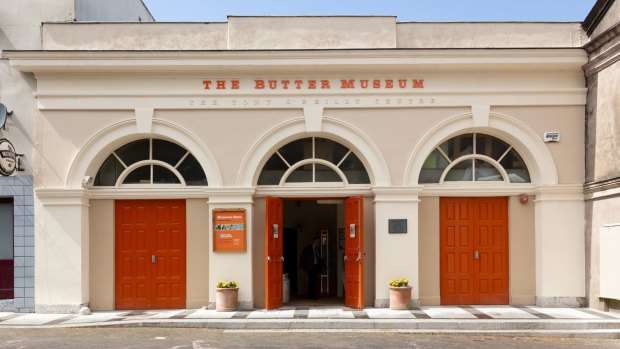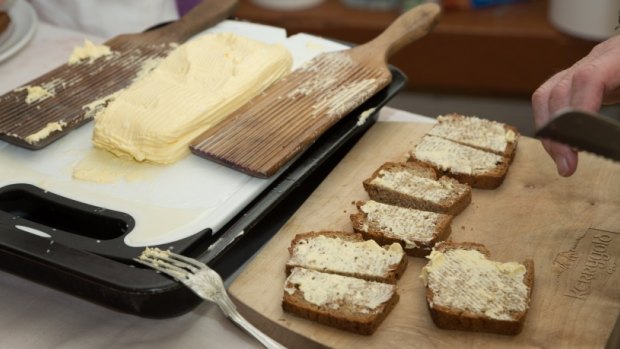This was published 1 year ago
Ireland's greatest export isn't whisky or Guinness

The Cork Butter Museum has everything you have ever wanted to know about butter production.
Once, this was the centre of the world, if you were into butter. If you were in the trade in the 1800s, if you made or you bought or sold butter, you were here, in Cork City.
All roads led to Cork back then, in the far south of Ireland. They were even called "butter roads". Farmers from Cork and its neighbouring counties would milk their cows, churn their butter and pack the product into a firkin, the traditional cannister, before loading up a horse and cart and making their way to the world's largest butter market.
There, the butter would be bought and exported around Ireland and indeed the world, shipped out of the Cork port and onto the Atlantic to Spain, the Netherlands, India, even the Caribbean.

Irish butter is still being transported around the world and is still phenomenally popular.
But then, everything changed.
That much is clear as you approach the old Cork Butter Exchange today, a once-grand building that is sliding now towards dereliction, with weeds growing from the tops of its thick Doric columns, and metal bars guarding entries that were once crowded with Cork's rich butter traders.
Industrialisation came along in the early 1900s and changed butter production forever, refining it and centralising it. Large farming co-ops were formed, diminishing the need for small-batch producers and the place for them to sell. Global tastes changed too, and the highly salted Cork butter went out of fashion.
In 1924, the Cork Butter Exchange closed for good.
Fortunately, however, it wasn't forgotten. The Irish have famously long memories, and not everyone is ready for Cork's proud butter-making past to melt into history's ether.
Look just left of those stone columns with their sprouting weeds and you see a building in far better condition: the Cork Butter Museum. Everything you have ever wanted to know about butter production in Cork – and, in fairness, plenty you didn't – is housed in these four walls.
And it's presented with such charming reverence. Step inside and you discover butter-making relics as lovingly displayed as if they were dinosaur bones; you find vintage butter wrappers treated like sacred parchments.
Places like this are so fascinating: museums with obscure niches, the products of passion for a local item or a cultural phenomenon that can seem to border on the mundane for the casual visitor. Butter, eh? The thing you spread on toast?
And yet stride around the Cork Butter Museum and you begin to understand what it means to this county and this city and its people. Butter has been made in Cork for millennia. It was once packed into firkins and buried in peat marshes for preservation – there's a 1000-year-old block of butter on display here – before Cork City became a major Atlantic trading port, and interest in the local butter sparked an industry.
The butter wrappers framed on the walls tell the story of the region, of an industry that began with so many tiny producers, but was eventually consolidated into one world-beating behemoth.
Because that's the thing about Irish butter: it's still being produced, still being transported around the world, and it is still phenomenally popular. Kerrygold is the second-highest-selling butter in the entire US – an amazing achievement, though one that must rankle a little in County Cork, where it all began.
Of course, the Cork Butter Exchange is no longer in use. It became a hat factory in the 1930s. It was a traditional-crafts centre for a while. And then, it was nothing. Just an oddly ambitious building in the otherwise working-class Shandon district, a testament to times past.
At least the Firkin Crane, a bold, circular building in front of the exchange where firkins were once cleaned before being sent back to the dairy farms, is getting some use: it's now the permanent base of Cork City Ballet and the Crux Dance Theatre.
There's clearly hope yet for the exchange – set in the sort of neighbourhood, so near the city centre, that is usually gentrified before long – to be transformed once again into the centre of someone else's world. Until then, its memory has been preserved.
THE DETAILS
VISIT
The Cork Butter Museum is on O'Connell Square in Shandon, Cork and is open daily in summer, Wednesday to Sunday from March to May, and on weekends in winter. Admission is €5 for adults ($8). See thebuttermuseum.com
MORE
Ben Groundwater was a guest of Tourism Ireland.
Sign up for the Traveller Deals newsletter
Get exclusive travel deals delivered straight to your inbox. Sign up now.